Parappanangadi
Parappanad | |
|---|---|
Municipality | |
 Parappanangadi railway station | |
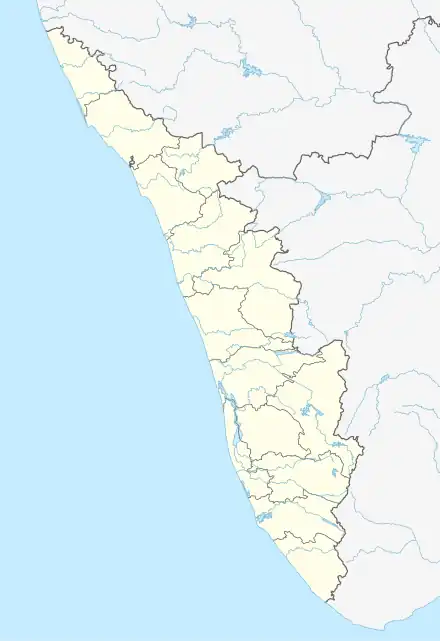 Parappanangadi Location in Kerala, India | |
| Coordinates: 11°02′59″N 75°51′27″E / 11.04972°N 75.85750°E | |
| Country | |
| State | Kerala |
| District | Malappuram |
| Government | |
| • Body | Parappanangadi Municipality |
| Area | |
| • Total | 22.5 km2 (8.7 sq mi) |
| Population (2011)[1] | |
| • Total | 71,239 |
| • Density | 3,200/km2 (8,200/sq mi) |
| Languages | |
| • Official | Malayalam, English |
| Time zone | UTC+5:30 (IST) |
| PIN | 676303 |
| Telephone code | 0494 |
| Vehicle registration | KL-55, KL-65, KL-10 |
| Nearest city | Malappuram |
| Literacy | 100% |
| Lok Sabha constituency | Ponnani |
| Civic agency | Parappanangadi Municipality |
| Climate | normal (Köppen) |
| Website | parappanangadimunicipality |
Parappanangadi (IPA: [pɐɾɐpːɐn̺ɐŋːɐːɖi]) is a major town and a municipality in Tirurangadi taluk of Malappuram district, Kerala, India. It is a coastal town located close to the Arabian sea.
Parappanangadi railway station is one of the oldest railway stations in Kerala. It was a part of the first rail route (Tirur–Chaliyam) in Kerala.[2] Parappanangadi is located 9 km (5.6 mi) north of Tanur on Tirur-Kadalundi Tipu Sultan Road.[3] The town lies on the bank of Kadalundi River.[4] Parappanangadi is located north of the estuary of Poorappuzha River, which is a tributary of Kadalundi River, and south of the estuary of Kadalundi River, which lies in Vallikkunnu.[4] Parappanangadi was one of the major ports in the southwestern coast of India during the medieval period.[5]
The region was ruled by the kingdom of Parappanad, who were vassals to the Zamorin of Calicut, and had the jurisdiction up to Beypore port to the north.[5] In the early medieval period, under the chiefs of Kozhikode and Parappanangadi, Parappanangadi developed as one of the important maritime trade centre on the Malabar Coast.[5] Later it became a part of Eranad Taluk in Malabar District under British Raj.[5]
Nadukani-Parappanangadi Road connects the coastal area of Malappuram district with the easternmost hilly border at Nadukani Churam bordering Nilgiris district of Tamil Nadu, near Nilambur.[6] It passes through major towns such as Tirurangadi, Malappuram, Manjeri, and Nilambur, before reaching the Nadukani Ghat Road.[6] The Koyi Thampurans of Travancore belongs to Parappanad Royal Family. Parappanad royal family is a cousin dynasty of the Travancore royal family.
History
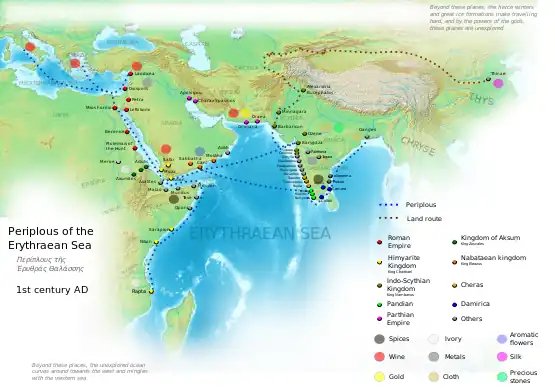
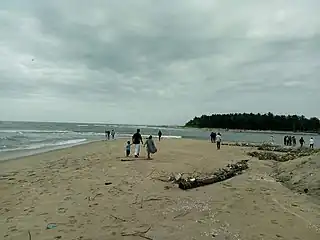
This town was the headquarters of Parappanad Kingdom during the medieval period.[7] Parappanangadi, which was then an important centre of trade, was known by the name Barburankad to the Arabs.[8] The kingdom of Parappanad had right over Vallikkunnu-Kadalundi-Chaliyam-Beypore region, which is often identified with the ancient maritime trading port of Tyndis, which was a major center of trade, next only to Muziris, between the Cheras and the Roman Empire, during Sangam period (1st-4th century CE).[9]
Pliny the Elder (1st century CE) states that the port of Tyndis was located at the northwestern border of Keprobotos (Chera dynasty).[10] The North Malabar region, which lies north of the port at Tyndis, was ruled by the kingdom of Ezhimala during Sangam period.[11]
According to the Periplus of the Erythraean Sea, a region known as Limyrike began at Naura and Tyndis. However the Ptolemy mentions only Tyndis as the Limyrike's starting point. The region probably ended at Kanyakumari; it thus roughly corresponds to the present-day Malabar Coast. The value of Rome's annual trade with the region was estimated at around 50,000,000 sesterces.[12] Pliny the Elder mentioned that Limyrike was prone by pirates.[13]
The Cosmas Indicopleustes mentioned that the Limyrike was a source of peppers.[14][15]
According to the Legend of Cheraman Perumals, the first Indian mosque was built in 624 AD at Kodungallur with the mandate of the last the ruler (the Cheraman Perumal) of Chera dynasty, who converted to Islam during the lifetime of Prophet Muhammad (c. 570–632).[16][17][18][19] According to Qissat Shakarwati Farmad, the Masjids at Kodungallur, Kollam, Madayi, Barkur, Mangalore, Kasaragod, Kannur, Dharmadam, Panthalayini, and Chaliyam (Chaliyam was a part of Parappanad), were built during the era of Malik Dinar, and they are among the oldest Masjids in Indian Subcontinent.[20]

The palace of the Kshatriya family of Parappanad Rajas is located at a short distance from Parappanangadi railway station. It was from this family that the consorts of the Rani's Travancore family were usually selected.[7]
In 1425, the country was divided into Northern Parappanad (Beypore Swaroopam) and Southern Parappanad (Parappur Swaroopam).[5]
The rulers of Parappanad Swaroopam were vassals to the Zamorins of Calicut.[7] The rulers of Parappanad were one of the Kshatriya claiming lineages of medieval Kerala along with the neighbouring Vettathunad rulers and the Cochin Royal Family.[21]
Parappanangadi was an important coastal town under the Zamorin rule and was one of the major trade centres of the medieval Kerala coast.[22] Arab traders had the monopoly of trade until 15th century CE.[22] In 1573, the Portuguese apparently burned down this town.[8]
The schools built by Basel Evangelistic Mission (BEM) at Parappanangadi and Ponnani during colonial era, have their positions among the oldest modern schools in Kerala.[23] During colonial period, Parappanangadi was placed under the Eranad Taluk of Malabar District.[5] Later in 1957, it became a part of Tirur Taluk, when the Taluk was formed.[7] In 1990's Parappanangadi became a part of the newly formed Tirurangadi Taluk.[24]
Lakshmipuram Palace
Lakshmipuram Palace is the royal palace of the Parappanad royal families at Changanassery. Palace is located at Puzhavathu near to Kavil Bhagavathy Temple.[25] The Lakshmipuram Palace was built in 1811 AD by Travancore ruler Maharani Ayilyom Thirunal Gouri Lakshmi Bayi (1791–1815) on behalf of the family of her husband Raja Raja Varma Valiya Koil Thampuran.[26] Until then, the royal family at the Neerazhi Palace in Changanacherry had been moved to newly built Lakshmipuram Palace.[27]
One of the royal families from Parappanad settled in Neerazhi Palace in the 18th century.[28]
Raja Raja Varma Koil Thampuran, father of Travancore Maharaja Swathi Thirunal Rama Varma, was born in Neerazhi Palace in Changanassery. He was part of the royal family of erstwhile Parappanad (Parappangadi and Beypore), Malabar.[29] Maharani Ayilyom Thirunal Gouri Lakshmi Bayi built a new palace in Changanassery for her husband and his family members during her reign in 1811, which was called Lakshmipuram Palace. Until then, the royal family lived in Neerazhi Palace at Puzhavathu.[30][31]
Kilimanoor palace
In 1705 (ME 880), the son and two daughters of Ittammar Raja of Parappanad royal house were adopted into the Royal house of Venad. Ittammar Raja's sister and her sons, Rama Varma and Raghava Varma, settled in Kilimanoor and married the now adopted sisters. Marthanda Varma, the founder of the Kingdom of Travancore, was the son of Raghava Varma. The nephew of Raghava Varma, Ravi Varma Koil Thampuran, married the sister of Marthanda Varma. Their son was Dharma Raja Kartika Thirunnal Rama Varma.
In 1740, when an allied force, led by Dutchman Captain Hockert supporting the Deshinganadu King, attacked Venad, an army from Kilimanoor resisted and then defeated them. Although a small victory, this was the first time an Indian army had defeated a European power.
In 1753, in recognition of this feat, Marthanda Varma exempted the areas controlled by the Kilimanoor palace (most of the area under the present Kilimanoor and Pazhayakunnummel panchayats) from taxes, and granted them autonomous status.
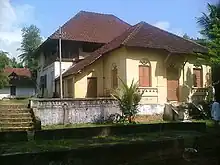
Civic administration
The town is administered by Parappanangadi Municipal Council, headed by a Chairman/Chairperson. For administrative purposes, the town is divided into 45 wards,[32] from which the members of the municipal council are elected for a term of five years.
Parappanangadi Municipality Election 2020
| S.No. | Party Name | Party symbol | Number of Councillors |
|---|---|---|---|
| 01 | UDF |  | 27 |
| 02 | Independents |  | 09 |
| 03 | LDF | _Logo.svg.png.webp) | 06 |
| 04 | BJP | 03 |
Municipal Council (2020-2025)
| Chairman | A Usman |
| Vice Chairperson | Shaharbanu K |
| Standing Committee Chairman/Chairpersons | |
| Finance Standing Committee Chairperson | Shaharbanu K |
| Development Standing Committee Chairman | P.V Musthafa |
| Welfare Standing Committee Chairperson | KP Muhsina |
| Health Standing Committee Chairman | P.P Shahul Hameed |
| Public works Standing Committee Chairperson | Zeenath Alibappu A |
| Education, Art, Sports Standing Committee Chairman | C Nizar Ahammed |
| Councilors | |
| KC NASAR | |
| M. C. NASEEMA | |
| K.K SAITHALAVIKOYA THANGAL | |
| SUMIRANI O | |
| KP RAMLA TEACHER | |
| SUHARA VK | |
| SUBRAHMANIAN | |
| JAYADEVAN CHERUKUTTIYIL | |
| RAMLATH KODALIKKODAN | |
| KP MEREENA TEACHER | |
| GIREESH CHALERI | |
| FATHIMA RAHEEM | |
| KHADEEJATHUL MARIYA | |
| SAMEER M | |
| SHAHINA SAMEER | |
| NM SHAMEJ | |
| KHAIRUNNISA THAHIR | |
| AV HASSAN KOYA | |
| ABDUL AZEEZ KOOLATH | |
| KASMIKOYA CV | |
| JAFARALI NECHIKKATT | |
| HAREERA HASSAN KOYA | |
| DEEPA | |
| ABDUL RAZAK TR | |
| MOHANDAS MASTER | |
| JAINISHA MANNARAKKAL | |
| UMMUKULSU | |
| KUNNUMMAL JUBAIRIYATH | |
| KARTHIKEYAN T | |
| BABY ACHUTHAN | |
| FOUSIYABI | |
| ABDUL RAZAK T | |
| FOUSIYA SIRAJ | |
| MANJUSHA PRALOSH | |
| SAITHALAVI AJYARAKATH | |
| B.P SAHIDA | |
| NASEEMA P.O | |
| FOUSIYA MUHAMMED | |
Law and Order
The municipality comes under the jurisdiction of the Parappanangadi police station, which was formed on 22 June 1979.[35] The station is located on Neduva area of Parappanangadi Municipality. The station has the jurisdiction over the municipality of Parappanangadi and the Gram panchayat of Vallikkunnu. (The 4 Revenue villages are Parappanangadi, Vallikkunnu, Neduva, and Ariyallur.)[35]
The jurisdictional courts of Parappanangadi Police Station are Judicial First Class Magistrate Court Parappanangadi, Parappanangadi Munsiff Court, Subdivisional Magistrate Court Tirur, and Sessions Court Manjeri.[35]
The border police stations are headquartered at Tenhipalam, Tanur, and Tirurangadi.[35] Parappanangadi Police Station comes under the Tanur subdivision of Malappuram District Police, which is also one among six subdivisions of district police.[36]
Important Courts at Parappanangadi
- Judicial First Class Magistrate Court - I, Parappanangadi
- Judicial First Class Magistrate Court - II, Parappanangadi
- Parappanangadi Munsiff Court[35]
Geography
Parappanangadi Municipality is bounded by Arabian Sea to west, Kadalundi River to east, Vallikkunnu Grama panchayat to north, and Tanur Municipality to south.[24]
Transportation
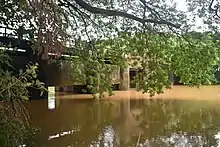
The nearest airport is at Karipur. Parappanangadi has railway station in the Town.[3] The nearest major railway station is at Tirur.[3]
Nadukani-Parappanangadi Road connects the coastal area of Malappuram district with the easternmost hilly border at Nadukani Churam bordering Nilgiris district of Tamil Nadu, near Nilambur, passing through major towns such as Tirurangadi, Malappuram, Manjeri, and Nilambur.[6]
Parappanangadi-Manjeri Road and Chettippadi-Chamravattam Road are two important Roads starting/ending at Parappanangadi.[35] Tirur-Kadalundi Tipu Sultan road passes through the town.[3]
Wards of Parappanangadi

Parappanangadi Municipality is composed of the following 45 wards:[37]
| Ward no. | Name | Ward no. | Name |
|---|---|---|---|
| 1 | Vadakke Kadappuram | 2 | Laksham Veedu |
| 3 | Health Centre | 4 | Chettipadi East |
| 5 | Anappadi | 6 | Moduvingal |
| 7 | Keezhchira | 8 | Kovilakam |
| 9 | Ullanam Town | 10 | Ullanam North |
| 11 | Edathiruthikkadavu | 12 | Thayyilappadi |
| 13 | Panayathil | 14 | Putharikkal |
| 15 | Stadium | 16 | Attakuzhingara |
| 17 | Karinkavu | 18 | Karingallathani |
| 19 | Palathingal | 20 | Keezhanalloor |
| 21 | Kottanthala | 22 | Naseeb Nagar |
| 23 | Chiramangalam South | 24 | Chiramangalam |
| 25 | Uppunipuram | 26 | Aviyil Beach |
| 27 | Kurikkal Road | 28 | Puthen Kadappuram |
| 29 | Saddam Beach | 30 | Puthen Kadappuram South |
| 31 | NCC Road | 32 | Parappanangadi South |
| 33 | Parappanangadi Town | 34 | Puthen Kadappuram |
| 35 | Ottummal South | 36 | Chappappadi |
| 37 | Anjappura | 38 | Neduva |
| 39 | Kodappalli | 40 | Angadi |
| 41 | Yarathingal | 42 | Chengattupadam |
| 43 | Chettipadi | 44 | Alungal South |
| 45 | Alungal North |
Notable individuals from Parappanangadi
Kerala Varma Valiya Koyi Thampuran (Kerala Kalidasan), Raja Raja Varma (Kerala Panini) and Raja Ravi Varma (Famous Painter) are from different branches of Parappanad Raja Vamsam (Clan) which migrated to Harippad, Changanassery, Mavelikkara and Kilimanoor.[38] Marthanda Varma, the founder of Travancore, belongs to Parappanad royal family. The former Chief Editor of the daily "The Hindu" (1898 to 1905) and Founder Chief Editor of "The Indian Patriot" Divan Bahadur Cozhisseri Karunakara Menon (1863–1922) was also from Parappanangadi.[39] O. Chandu Menon wrote his novels "Indulekha" and "Saradha" while he was the judge at Parappanangadi Munciff Court. Indulekha is also the first Major Novel written in Malayalam language. Twentieth century Islamic scholar, reformer in Islamic education in Kerala, founder of Kerala Jamiyyathul Ulama[40] and Madeenathul Uloom Arabic College [41] M.C.C Abdul Rahman Moulavi (1906–1964) was from Parappanangadi. He was the son of Chalilakath Kunahmed Haji, a renowned Islamic scholar and reformist. Former Education Minister of Kerala, P. K Abdul Rabb.[42] Unnikrishnan Panicker, a renowned astrologer.
References
- ↑ "Population of Parappanangadi". parappanangadimunicipality.lsgkerala.gov.in. Retrieved 14 July 2020.
- ↑ "Kerala Travels".
- 1 2 3 4 "ആ ചൂളംവിളി പിന്നെയും പിന്നെയും..." Mathrubhumi. 17 June 2019. Retrieved 19 December 2020.
- 1 2 "Physical divisions of Malappuram" (PDF). censusindia.gov.in. pp. 21–22. Retrieved 18 April 2020.
- 1 2 3 4 5 6 Logan, William (2010). Malabar Manual (Volume-I). New Delhi: Asian Educational Services. pp. 631–666. ISBN 9788120604476.
- 1 2 3 Special Correspondent (12 February 2020). "നാടുകാണി–പരപ്പനങ്ങാടി റോഡ് ടാറിങ് തുടങ്ങി; വീതികൂട്ടലും ഓടനിർമാണവും പിന്നീട്". Manorama Online.
- 1 2 3 4 Devassy, M. K. (1965). District Census Handbook (2) - Kozhikode (1961) (PDF). Ernakulam: Government of Kerala.
- 1 2 S. Muhammad Hussain Nainar (1942). Tuhfat-al-Mujahidin: An Historical Work in The Arabic Language. University of Madras.
- ↑ Yogesh Sharma, Coastal Histories: Society and Ecology in Pre-modern India, Primus Books 2010.
- ↑ Gurukkal, R., & Whittaker, D. (2001). In search of Muziris. Journal of Roman Archaeology, 14, 334-350.
- ↑ A. Shreedhara Menon, A Survey of Kerala History.
- ↑ According to Pliny the Elder, goods from India were sold in the Empire at 100 times their original purchase price. See
- ↑ Bostock, John (1855). "26 (Voyages to India)". Pliny the Elder, The Natural History. London: Taylor and Francis.
- ↑ Indicopleustes, Cosmas (1897). Christian Topography. 11. United Kingdom: The Tertullian Project. pp. 358–373.
- ↑ Das, Santosh Kumar (2006). The Economic History of Ancient India. Genesis Publishing Pvt Ltd., p. 301.
- ↑ Jonathan Goldstein (1999). The Jews of China. M. E. Sharpe. p. 123. ISBN 9780765601049.
- ↑ Edward Simpson; Kai Kresse (2008). Struggling with History: Islam and Cosmopolitanism in the Western Indian Ocean. Columbia University Press. p. 333. ISBN 978-0-231-70024-5. Retrieved 24 July 2012.
- ↑ Uri M. Kupferschmidt (1987). The Supreme Muslim Council: Islam Under the British Mandate for Palestine. Brill. pp. 458–459. ISBN 978-90-04-07929-8. Retrieved 25 July 2012.
- ↑ Husain Raṇṭattāṇi (2007). Mappila Muslims: A Study on Society and Anti Colonial Struggles. Other Books. pp. 179–. ISBN 978-81-903887-8-8. Retrieved 25 July 2012.
- ↑ Prange, Sebastian R. Monsoon Islam: Trade and Faith on the Medieval Malabar Coast. Cambridge University Press, 2018, p. 98.
- ↑ Unni, K. Raman (31 May 1961). "Caste in south Malabar a study of social stratification in south Malabar". Maharaja Sayajirao University of Baroda: 108 – via Shodhganga.
- 1 2 K. V. Krishna Iyer Zamorins of Calicut: From the Earliest Times to AD 1806. Calicut: Norman Printing Bureau, 1938
- ↑ Leelakrishnan, Alamkode (17 June 2019). "അമ്പതിന്റെ നിറവില് മലപ്പുറം; മലപ്പുറത്തിന്റെ മാനവിക മഹാപൈതൃകം". Mathrubhumi.
- 1 2 Directorate of Census Operations, Kerala. District Census Handbook, Malappuram (PDF). Thiruvananthapuram: Directorate of Census Operations, Kerala.
- ↑ P. Shungoonny Menon - A HISTORY OF TRAVANCORE - First edition: 1878 , New edition: 1983, Page 130, 131 - ISBN 978-8170200406
- ↑ The Travancore State Manual Vol 1 to 4; Publisher : Kerala Council for Historical Research; ISBN 8185499268; Edition : 1996; Pages: 2500; Author:T.K. Velu Pillai; Editor:S.Raimon; Category:Manuals; Year of Publishing:1940
- ↑ Encyclopedia of Tourism Resources in India; Author: Dr. Manohar Sajnani, Published in 2001, Published by: Kalpaz Publications; Address: C-30, Satyawati Nagar, Phase-III, Ashok Vihar, Delhi-110052, ISBN 81-7835-014-9 (set), ISBN 81-7835-018-1 (Vol II)
- ↑ Menon, P Shungoonny (1878). History of Travancore from the Earliest Times by P Shungoonny Menon (Dewan Peishcar of Travancore). 105, Mount Road, Madras: Higginbotham and Company. pp. 152, 153.
- ↑ Visakham Thirunal - Editor: Lennox Raphael Eyvindr - ISBN 9786139120642
- ↑ History of Travancore from the Earliest Times - P. Shungoonny Menon - ISBN 8120601696 - Published By: Asian Educational Services
- ↑ Lennox Raphael Eyvindr, ed. (2012). Visakham Thirunal. p. 168. ISBN 978-6139120642.
- ↑ "Parappanangadi municipality". lsgkerala. Retrieved 25 March 2021.
- ↑ "Parappanangadi Municipality election of 2020". lbtrend. Retrieved 9 December 2020.
- ↑ "LSGI Election -2020 - Elected Council Members". lsgkerala.gov.in.
- 1 2 3 4 5 6 "Parappanangadi PS". Kerala police. Retrieved 25 March 2021.
- ↑ "Tanur Subdivision". Keralapolice.gov.in. Retrieved 24 March 2021.
- ↑ "Wards of Parappanangadi". sec.kerala.gov.in.
- ↑ Visakham thirunal. [Place of publication not identified]: Duc. 2012. ISBN 978-613-9-12064-2. OCLC 940373421.
- ↑ Some Madras Leaders. Allahabad Printed at Standard Press. 1922.
- ↑ Mohammed, U. (2007). Educational Empowerment of Kerala Muslims: A Socio-historical Perspective. Other Books. ISBN 978-81-903887-3-3.
- ↑ "Madeenathul Uloom Arabic College". www.muacollege.ac.in.
- ↑ "Council of Ministers". 28 October 2011. Archived from the original on 28 October 2011. Retrieved 1 February 2020.